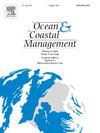Mapping the governance landscape of the blue bioeconomy: A systems approach to understanding innovation barriers and enablers
IF 5.4
2区 环境科学与生态学
Q1 OCEANOGRAPHY
引用次数: 0
Abstract
The blue bioeconomy offers promising pathways for sustainable marine resource management, yet its development faces significant governance challenges. This study examines how governance structures can enable or hinder innovation in emerging blue bioeconomy systems, focusing on the valorisation of fishery side-streams and microalgae development. Using a novel Governance of Innovation Systems (GOIS) framework adapted from Technological Innovation Systems theory, we analyse governance structures across four European regions: Sicily (Italy), Saaremaa (Estonia), Greenland and West Jutland (Denmark). Through desk research and 18 stakeholder interviews, we identify key barriers and enablers within six governance functions: knowledge development, direction of search, legitimacy creation, resource mobilisation, market formation and entrepreneurial experimentation. Our findings reveal that while market formation shows promise across regions, significant challenges persist in legitimacy creation and knowledge development. Regulatory complexity and fragmented responsibilities emerge as primary barriers to innovation, particularly affecting small and medium-sized enterprises. Resource constraints manifest differently across regions, from infrastructure limitations in Sicily to workforce shortages in Denmark and Estonia. Based on these insights, we propose three key policy interventions: regulatory process simplification through sandboxes and administrative one-stop shops, innovative financing mechanisms including blue bonds and accelerator programs, and enhanced collaborative frameworks through regional networks and public-private partnerships. This study contributes to innovation systems theory and practice by demonstrating how systematic analysis of governance functions can inform targeted interventions to support sustainable blue bioeconomy development.
绘制蓝色生物经济的治理景观:理解创新障碍和推动因素的系统方法
蓝色生物经济为可持续海洋资源管理提供了有希望的途径,但其发展面临着重大的治理挑战。本研究探讨了治理结构如何促进或阻碍新兴蓝色生物经济系统的创新,重点关注渔业侧流和微藻的发展。本文采用了一种基于技术创新系统理论的创新系统治理(GOIS)框架,分析了四个欧洲地区的治理结构:西西里岛(意大利)、萨雷马岛(爱沙尼亚)、格陵兰岛和西日德兰岛(丹麦)。通过案头研究和18个利益相关者访谈,我们确定了六个治理功能中的关键障碍和推动因素:知识开发、搜索方向、合法性创造、资源动员、市场形成和创业实验。我们的研究结果表明,虽然市场形成在各地区都有希望,但在合法性创造和知识发展方面仍然存在重大挑战。监管的复杂性和责任的分散成为创新的主要障碍,尤其影响到中小型企业。从西西里岛的基础设施限制到丹麦和爱沙尼亚的劳动力短缺,不同地区的资源限制表现不同。基于这些见解,我们提出了三项关键的政策干预措施:通过沙盒和一站式行政服务简化监管流程,创新融资机制,包括蓝色债券和加速器计划,以及通过区域网络和公私伙伴关系加强合作框架。本研究通过展示对治理功能的系统分析如何为有针对性的干预提供信息,以支持可持续的蓝色生物经济发展,为创新系统的理论和实践做出了贡献。
本文章由计算机程序翻译,如有差异,请以英文原文为准。
求助全文
约1分钟内获得全文
求助全文
来源期刊

Ocean & Coastal Management
环境科学-海洋学
CiteScore
8.50
自引率
15.20%
发文量
321
审稿时长
60 days
期刊介绍:
Ocean & Coastal Management is the leading international journal dedicated to the study of all aspects of ocean and coastal management from the global to local levels.
We publish rigorously peer-reviewed manuscripts from all disciplines, and inter-/trans-disciplinary and co-designed research, but all submissions must make clear the relevance to management and/or governance issues relevant to the sustainable development and conservation of oceans and coasts.
Comparative studies (from sub-national to trans-national cases, and other management / policy arenas) are encouraged, as are studies that critically assess current management practices and governance approaches. Submissions involving robust analysis, development of theory, and improvement of management practice are especially welcome.
 求助内容:
求助内容: 应助结果提醒方式:
应助结果提醒方式:


